Abstract
The transportation sector mainly relied on fossil fuel and is one of the major causes of climate change and environmental pollution. Advances in smart sensing technology are paving the way for the development of clean and intelligent vehicles that lead to a more sustainable transportation system. In response, the automotive industry is actively engaging in new sensor technologies and innovative control and diagnostic algorithms that improve energy sustainability and reduce vehicle emissions. In particular, recent regulations for diesel vehicles require the integration of smart soot sensors to deal with particulate filter on-board diagnostic (OBD) challenges. Meeting the recent, more stringent OBD requirements will be difficult using traditional diagnostic approaches. This study investigates an advanced diagnostic strategy to assess particulate filter health based on resistive soot sensors and available engine variables. The sensor data are projected to generate a 2D signature that reflects the changes in filtration efficiency. A relevant feature (character) is then extracted from the generated signature that can be transformed into an analytical expression used as an indicator of DPF malfunction. The diagnostic strategy uses an adaptive approach that dynamically adjusts the signature’s characters according to the engine’s operating conditions. A correction factor is calculated using an optimization algorithm based on the integral of engine speed measurements and IMEP set points during each sensor loading period. Different cost functions have been tested and evaluated to improve the diagnostic performance. The proposed adaptive approach is model-free and eliminates the need for subsystem models, iterative algorithms, and extensive calibration procedures. Furthermore, the time-consuming and inaccurate estimation of soot emissions upstream of the DPF is avoided. It was evaluated on a validated numerical platform under NEDC driving conditions with simultaneous dispersions on engine-out soot concentration and soot sensor measurements. The promising results highlight the robustness and superior performance of this approach compared to a diagnostic strategy solely reliant on sensor data.
1. Introduction
The transportation sector is a major contributor to global energy consumption and air pollution. In response, the automotive industry is actively addressing these challenges by developing advanced technologies to enhance energy efficiency and reduce vehicle emissions. A key development in this effort is the advancement of intelligent sensing technology, which is enabling the production of clean, efficient vehicles and supporting a more sustainable transportation system [1,2,3,4]. Recent years have seen rapid advancements in new energy vehicle technology; however, diesel-powered vehicles continue to dominate the market due to their high thermal efficiency and reliable performance. As a result, transportation systems are expected to continue to rely on diesel vehicles in the near future [5,6,7].
Despite their exceptional performance, diesel engines generate significant fine particulate matter (PM) emissions, posing serious environmental and health risks. To address these issues and comply with increasingly stringent emissions regulations, effective exhaust pollutant control technologies are being incorporated into all aspects of vehicle design. Modern diesel engines are continuously optimized to enhance combustion processes and improve the efficiency of aftertreatment systems [8,9], with a particular focus on reducing soot emissions, which are known to contribute to environmental pollution and severe respiratory health problems [10,11,12,13]. Several solutions to minimize soot emissions have been widely investigated, including the adoption of new combustion modes [14,15,16], the use of alternative fuels and fuel additives [17,18], and the integration of diesel particulate filters (DPFs) [19,20]. Among these, DPFs are one of the most effective methods for meeting stringent emissions standards. This aftertreatment device uses thousands of adjacent, alternating channels to trap PM from exhaust gases efficiently [5,20,21]. Consequently, DPFs have become a widely adopted solution among automotive manufacturers to mitigate particulate matter emissions and meet the increasingly tighter emission limits.
While DPF technology has significantly reduced particulate matter emissions, soot emissions continue to pose challenges. A primary challenge is the successful regeneration of the DPF to ensure effective soot removal across diverse engine operating conditions [22,23]. Particulate filter malfunctions are frequently associated with high temperature gradients arising from uncontrolled regeneration [24,25]. Such failures with the natural aging of DPFs may compromise the filter’s efficiency over the vehicle’s lifespan, potentially leading to high levels of soot emissions downstream of a faulty filter, thereby approaching legislative emission limits.
To address these issues, an on-board diagnostic (OBD) algorithm is essential for monitoring soot emissions from the DPF. The algorithm must detect early-stage DPF failures, triggering a malfunction indicator light to signal the need for filter replacement. Traditional diagnostic methods utilize differential pressure sensors that monitor pressure drops across the DPF. However, recent legislation mandates the detection of even minor DPF leaks, requiring OBD compliance with stricter standards. Standard methods face challenges in meeting these increasingly stringent regulations [25,26,27]. Thus, achieving compliance requires advanced techniques beyond traditional methods [26,28,29]. Recent diagnostic strategies emphasize direct measurements of soot particles using dedicated sensors [30,31,32,33]. Resistive soot sensors have emerged as a promising technology for monitoring soot accumulation in diesel particulate filters (DPFs). Currently, they represent the conventional solution for detecting particulate filter failures. This article proposes a diagnostic strategy utilizing resistive soot sensor data. The resistive technology is widely adopted in vehicle OBD systems and is well-suited for mass production due to its simplicity, commercial viability, and cost-effectiveness [33,34,35]. Resistive sensors collect soot particles cumulatively, providing sufficient sensitivity to detect minor DPF leaks and ensuring compliance with recent OBD limits. Additionally, they are highly reliable, even in the harsh conditions of exhaust line [27], and ongoing efforts are focused on enhancing their performance [35,36].
Based on suitable soot sensor measurements, two distinct approaches can be used to design the diagnostic algorithm. A model-based approach that relies on a combination of soot sensor and particle filter models with a real-time engine-out soot estimator. This approach necessitates extensive calibration of the soot estimator and associated models, which can potentially lead to significant overall uncertainties due to inaccuracies in estimation and model variations [26,37]. The second approach exploits a soot sensor in conjunction with available engine variables, eliminating the use of soot estimators and physical models [2,28,29]. Recently, a model-free, signature-based strategy [4,38,39] has been proposed for DPF diagnostics using resistive soot sensors. It provides a DPF malfunction indicator (character) with superior performance compared to the commonly used sensor loading time. It highlights the effect of variations on filtration efficiency while mitigating the impacts of engine-out emissions variations and sensor response dispersions [40].
This study proposes adaptive DPF diagnostics that exploit available engine variables in conjunction with the aforementioned signature-based method. The adaptive approach dynamically adjusts the signature character by applying a correction factor determined by an optimization algorithm. This approach improves diagnostic performance by adapting the character to the specific operating conditions in terms of engine speed and IMEP (Indicated Mean Effective Pressure) setpoint. The optimization algorithm minimizes a cost function that incorporates the mean and standard deviation of the corrected faulty and nominal signature characters. This process is based on a training dataset representing 20% of the total tested data. The data are obtained from an experimentally validated platform operating under the New European Driving Cycle (NEDC) [25,28,40]. Relevant dispersions are added to engine-out soot concentration and sensor response. The obtained results show the effectiveness of the adaptive strategy to accurately distinguish between nominal and faulty filters. This approach produces a robust diagnostic algorithm that significantly reduces false alarm and missed detection rates compared to an algorithm relying solely on the sensor signal. A statistical analysis was performed to select a relevant detection threshold.
The paper is organized as follows. Section 2 provides a comprehensive overview of the resistive soot sensor principle and its operational mechanisms, with a particular focus on its applicability to DPF diagnostics. The sensor’s responses to both faulty and nominal conditions are presented and analyzed. In Section 3, the signature method with the associated diagnostic scheme is presented. The key benefits and underlying motivations of this method are explicitly outlined. Section 4 describes the specific challenges and complexities inherent in the DPF diagnostic problem. In Section 5, the adaptive diagnostic strategy is presented in detail, highlighting its ability to address these challenges. The proposed solution is exposed and thoroughly discussed. In Section 6, a comparative analysis is conducted to contrast the performance of the proposed adaptive diagnostic strategy with the non-adaptive approach. The analysis aims to demonstrate the superior performance and advantages of the adaptive strategy. The paper concludes by summarizing the key findings and insights gained from the proposed research work.
2. Resistive Soot Sensor
The sensor used in this paper is based on the proven, well-known resistive technology. Resistive soot sensors have emerged as a promising technology for monitoring soot accumulation in diesel particulate filters (DPFs). Currently, they represent the conventional solution for detecting particulate filter failures. These sensors operate by measuring changes in electrical resistance caused by the deposition of soot particles on a sensing element. The change in resistance is directly correlated to the amount of soot deposited. Soot particles are trapped on a ceramic surface positioned within two interdigitated electrodes (see Figure 1). The sensing surface, which is exposed to the exhaust flow, is connected to a DC voltage. The sensing principle exploits the electrical conductivity of soot particles to detect their presence and quantify their accumulation.
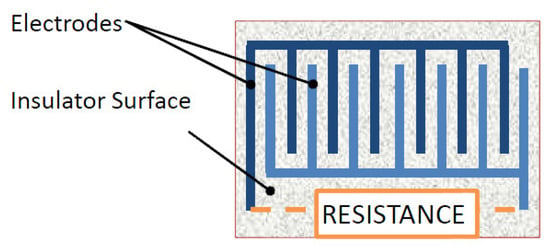
Figure 1.
Conductive particles are trapped on a ceramic substrate within two interdigitated electrodes.
During operation, soot particles emitted in the exhaust line accumulate on the sensor surface and form conductive pathways between the electrodes. Initially, the sensor has a high resistance due to the ceramic material. As soot particles accumulate and create the first conductive path, the resistance begins to decrease, a phenomenon known as percolation. This decreasing resistance continues as more soot particles are trapped and additional conductive paths are established. This decreasing phenomenon persists as additional soot particles accumulate, creating further conductive pathways between the electrodes. Figure 2 illustrates the resistive sensor operating principle.
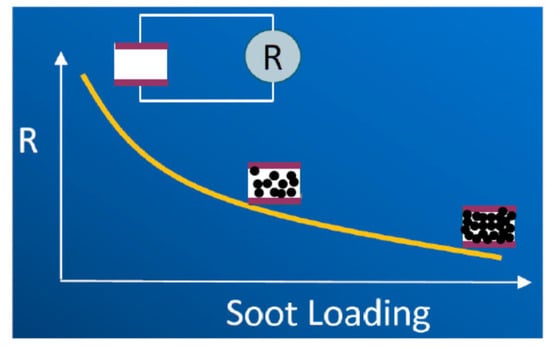
Figure 2.
The sensor signal falls with increasing soot accumulation until reaching a predetermined lower level, at which point sensor regeneration should be initiated to begin a new cycle.
The sensor traps soot particulate from the exhaust gas downstream of the DPF. Once an initial conductive soot bridge is formed inside the electrodes, the resistance begins to decrease. The resistance signal continues to decline as more particles accumulate until a lower limit is reached. A new cycle starts by heating the sensor to burn off the soot layer. The electric current for high-temperature soot combustion is provided via a dedicated circuit on the sensor’s rear surface. The regeneration phase is completed in about one minute, after which the sensor is ready to capture soot particles again. Consequently, when positioned downstream of the DPF, the sensor’s output depends on the quantity of soot exiting the particulate filter. It is important to note that the loading response may vary under identical conditions. Response variations of up to 15% are considered here. More details regarding sensor design and functioning can be found in [2,25].
This study focuses on European Union emissions regulations that mandate the detection of DPF failure before soot emissions exceed the OBD limit of 12 mg/km, using the NEDC (New European Driving Cycle) [26,40]. The diagnostic assessment of faulty DPFs, where soot emissions exceed the OBD limit, must be conducted during certification using a maximum of three NEDC cycles. Additionally, diagnostics must be performed under real-world conditions at a minimum frequency as specified by the In-Use Performance Ratio (IUPR) standard. Figure 3 shows the NEDC cycle with samples of soot sensor responses for both healthy and faulty filters on a succession of two driving cycles.

Figure 3.
NEDC driving cycle with normalized sensor responses obtained with a succession of two driving cycles.
As expected, the faulty filter leads to higher regeneration cycles than the nominal filter due to the increase in soot concentration downstream of the filter when its efficiency decreases. Consequently, the sensor loading time is lower for the faulty case. Therefore, the loading time is considered a standard fault indicator for the DPF diagnostic algorithm. The signature-based approach described in Section 3 gives a fault indicator with higher sensitivity to DPF malfunction in comparison with the commonly used sensor loading time. It has the capacity to highlight the loss of filter efficiency while mitigating the impacts of sensor dispersions and engine emissions fluctuations.
The soot sensor must ensure adequate sensitivity and accuracy while maintaining robust performance and durability in the harsh exhaust environment. The Sensor Control Unit (SCU) processes soot measurements and transmits relevant data concerning the Particulate Filter status to the Engine Control Unit (ECU). In an adaptive diagnostic framework, the SCU can also receive relevant variables depending on engine operations from the ECU. The proposed strategy integrates engine speed, IMEP (Indicated Mean Effective Pressure), and soot sensor measurements to enable adaptive DPF diagnostics. As demonstrated in Section 5, the proposed adaptive strategy provides an accurate DPF diagnostic and outperforms the diagnostic strategy that relies solely on the soot sensor signal. The following section describes the signature method employed to convert the resistance signal provided by the soot sensor into a relevant feature indicative of DPF status.
3. A 2D Signature for Dynamic System’s Diagnostic
This section introduces the fundamental concept of the signature method and the corresponding diagnostic structure. It reviews the essential mathematical background required for generating signatures and outlines the procedure for character (feature) extraction. The signature method provides a computationally efficient framework for estimating and diagnosing dynamic systems, especially nonlinear systems where traditional observer-based approaches are challenging. By projecting output progressions onto a 2D plane within a moving window, the method highlights relevant features that are difficult to identify using model-based techniques. This approach is robust to uncertainties and variations in operating conditions while allowing for customization to enhance sensitivity to specific malfunctions. The signature method addresses dynamic nonlinear systems described by the following structure:
where represents the system parameters, which vary within the ranges , , is the output while is the state vector.
The signature is inspired by the recognition that output progressions of dynamic systems capture valuable information related to internal behavior and can provide critical insights about a system’s operation. To extract relevant features, the approach projects the time-series data sampled over a specified interval onto a two-dimensional space. For nonlinear systems with dispersions and modeling inaccuracy, designing a systematic observer and optimization algorithm is cumbersome. The purpose is to provide a model-free approach relying solely on available sensor data. The signature is computed by projecting the past measurement vector combined with the current output onto the 2D space.
According to classical receding-horizon observability principles, the observable sub-state of the considered system may be potentially identified based on the knowledge of . This sub-state, along with the parameter vector p, uniquely determines the current output .
The previous relationship is characterized by its nonlinearity, multidimensionality, and dependence on system parameters subject to variations due to the system’s malfunction. The objective here is to visualize this unknown function through graphical representation, aiming to identify patterns that are sensitive to variations in these parameters, indicative of potential system malfunctions. Data projection of the measurements vector into the two-dimensional space is performed. This projection creates a zooming effect that highlights pattern variations that are correlated to internal malfunctions. The diagnostic challenge lies in extracting meaningful features that are highly sensitive to malfunctions while remaining robust to variations in operating conditions and data dispersion.
3.1. Signature Generation
The generation process employs basic mathematical operations with minimal computational burden, making the resulting diagnostic strategy well-suited for real-time applications where rapid malfunction detection is essential. The mathematical tool used for the generation process is recalled hereafter. First, the data are normalized using the following map :
where and ε is a regularizing coefficient. Vector comprises N past measurements collected at a constant sampling period.
A projection is subsequently used to map (Y, y+) to a 2D point with the following steps:
- Let the nodes of a regular polygon:
- Computation of vector is first performed.
- The component of determine the position of a point on each segment:
- Based on (, and are defined:
- Once and are obtained, the map is applied as follows:
- Consider now the following N-dimensional output vector :
The subsequent points are obtained by applying the projection to vectors in a moving data window, thereby defining the signature in the 2D space at current time t:
An overview of the above signature generation process is depicted on Figure 4.
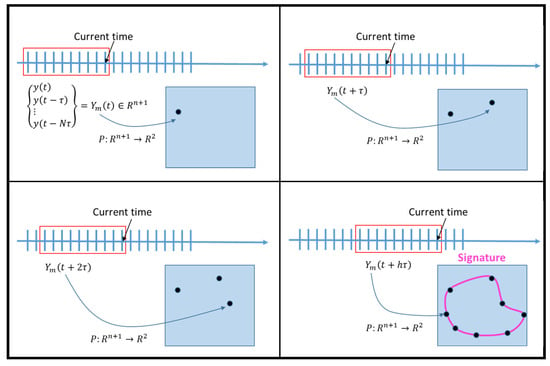
Figure 4.
An overview of the signature generation process as defined in the previous section, illustrated with a parameter value of N = 9.
3.2. Feature Extraction
Following the generation phase, relevant features (characters) that are essential for the diagnostic algorithm are identified. Characters are selected based on a detailed analysis of how system malfunctions alter the signature pattern.
where denote the vectors of x- and y-coordinates of the signature’s points, respectively. The selection procedure, which can be manual or automated, is based on the sensitivity of characters to variations in the signature pattern induced by system malfunctions. Samples of analytical characters are defined below:
The adaptive diagnostic strategy proposed here uses character coupled with available ECU variables. The resistive signal given by the soot sensor is used to generate a signature with order . The integrals of engine speed measurements and IMEP setpoints during each sensor loading time are used to provide an adaptive character. The purpose is to enhance the correlation between generated character and filtration efficiency while minimizing the impacts of operating conditions and data dispersions.
4. DPF Diagnostic
Reducing emissions from the transportation sector presents a significant challenge for manufacturers and regulatory authorities worldwide. In response, substantial research efforts are underway to improve the efficiency and onboard diagnostic capabilities of aftertreatment systems, particularly for diesel vehicles. Stricter regulations demand substantial reductions in soot emissions, with diesel particulate filters (DPFs) recognized as one of the most effective solutions for controlling particulate matter (PM) pollution.
DPFs capture soot particles by filtering exhaust gas through a porous wall, effectively reducing PM emissions. However, these filters have a finite capacity for retaining soot particles. Once saturated, accumulated particles must be removed to prevent engine performance degradation and elevated back pressure. This is achieved through a regeneration process that oxidizes and clears trapped soot, either periodically when a preset PM load threshold is reached or continuously during normal filter operation. A commonly used regeneration method is thermal regeneration, which raises exhaust gas temperature through delayed fuel injection. This elevated temperature facilitates soot oxidation, effectively cleaning the filter. Successful regeneration requires a minimum temperature and adequate oxygen concentration within the filter.
DPF malfunctions, however, can arise due to extreme temperature gradients during poorly controlled or uncontrolled regenerations. Excessive thermal stress can damage the DPF substrate, leading to melting, cracking, or permanent washcoat failure. A compromised DPF may develop leaks, significantly reducing filtration efficiency and potentially causing soot levels downstream of the filter to exceed regulatory limits.
To ensure sustained low emissions and regulatory compliance, effective monitoring and diagnostic algorithms for DPFs are essential. Traditionally, DPF malfunctions were detected using differential pressure sensors, which measure exhaust gas pressure differences across the filter. However, with the increasing stringency of PM regulations, this method is reaching its limits in terms of robustness and accuracy. The advent of reliable and cost-effective soot sensors has enabled the development of advanced diagnostic approaches that offer greater precision and ensure compliance and optimal filter performance. The DPF is considered faulty for a soot concentration higher than a specific level known as the On-Board Diagnostics limit. For such cases, the diagnostic algorithm must send a MIL (malfunction indicator light), alerting the need for filter maintenance or replacement.
A common diagnostic strategy for DPF systems involves the integration of subsystem models, coupled with soot estimations. This model-based strategy works by comparing the actual sensor signal with a simulated signal generated by a physical model. This model represents the DPF and the sensor, driven by a real-time estimate of engine soot emissions. By using a filter model that mimics a damaged filter, the diagnostic system can identify potential malfunctions. For example, if the actual response of the sensor is slower than the simulated one, this may indicate that soot emissions are below the OBD limit and vice versa. Conversely, if the actual sensor response is faster, this may suggest that the filter is not capturing soot particles effectively and a malfunction occurred.
While this model-based approach offers a simple implementation, it needs significant tuning efforts for soot estimations and underlying models. This calibration process is essential to ensure accurate emulation of sensor behavior and soot emissions. In addition, the risk of significant overall uncertainties arises from the combination of sensor dispersions with the inherent inaccuracies of modeling and estimation techniques.
To mitigate these challenges, advanced diagnostic techniques that integrate machine learning and data-driven approaches can be considered. These methods can leverage historical data and real-time sensor information to improve the accuracy and robustness of fault detection and diagnosis. In this context, the proposed diagnostic approach avoids traditional model-based methods and instead relies on direct soot measurements and available engine operating variables. This model-free strategy eliminates the need for complex subsystem models and the potential inaccuracies associated with soot emission estimation.
The European Union emission standards are considered here. These regulations require the detection of DPF failures before soot emissions exceed the OBD limit of 12 mg/km under the NEDC driving cycle. The DPF diagnostic strategy must exhibit robust performance under various driving conditions. This requires reliable operation during certification phases, encompassing up to three consecutive NEDC cycles, and in real driving scenarios. In the latter case, the fault detection frequency must meet the stringent requirements of the In-Use Performance Ratio (IUPR).
While the OBD threshold remains constant, statistical analysis is essential to ensure the reliability of the diagnostic algorithm under varying conditions. This analysis must account for inherent physical uncertainties and soot sensor variability. A robust diagnostic algorithm should be able to accurately detect DPF malfunctions while simultaneously minimizing false alarms for healthy filters with soot emissions below 4.5 mg/km during NEDC. To achieve these goals, both the sensor and the associated algorithm must provide accurate and prompt detection of DPF malfunctions. This ensures compliance with emission regulations and preserves environmental integrity.
The following section describes a robust DPF diagnostic strategy using soot sensor projection and an optimization algorithm. By combining the signature-based method with engine variables, the adaptive approach enhances diagnostic performance, mitigating the impact of sensor dispersions and dynamic driving conditions.
5. Adaptive Diagnostic Strategy
This section investigates an adaptive diagnostic strategy that takes advantage of available variables related to engine operating conditions coupled with the above signature method used to generate relevant character-sensitive o DPF filtration efficiency. The adaptive strategy aims to improve the diagnostic performance by applying a correction factor to the generated signature character. The correction factor that depends on engine operating conditions is obtained using an optimization algorithm. The resulting diagnostic algorithm uses signature’s points to compute an analytical expression of the chosen character that is dynamically corrected based on selected available engine variables. The adaptive signature diagnostic structure is shown in Figure 5.
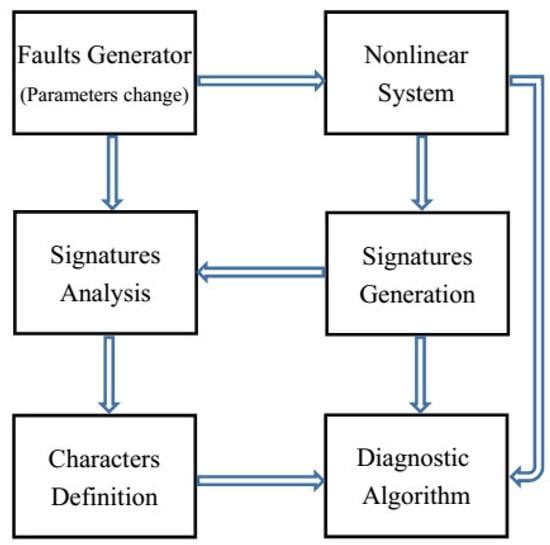
Figure 5.
Adaptive Signature based diagnostic strategy.
The system’s measurements are firstly used to generate 2D signatures for nominal and faulty DPF. Signature generation is carried out either using experimental data or by employing an appropriate numerical platform, where system parameters (faults) are systematically varied. A subsequent analysis phase is conducted to extract features sensitive to the generated faults. This process can be automated using specialized software or performed manually by an operator. The identified features are then translated into analytical expressions and integrated into the diagnostic algorithm. The latter exploits available variables related to the engine operating conditions to adjust the generated characters if necessary. This approach ensures that the signature’s character is dynamically adapted via a suitable correction factor in response to changing driving conditions. The correction factor is optimized based on the operating conditions to minimize a cost function for the purpose of enhancing the diagnostic capabilities in terms of missed detections and false alarms.
This methodology is applied hereafter to solve the above DPF diagnostic problem. The performance of the adaptive strategy is highlighted using numerical results based on a dedicated platform. The resistive sensor used for signature generation is provided by an experimentally validated soot sensor model and engine-out soot estimator. Standard practice for DPF modeling is based on constant filtration efficiency using soot concentrations upstream and downstream of the DPF on NEDC. The nominal filter corresponds to 4.5 mg/km of soot emissions downstream of the DPF, while the faulty filter emits 12 mg/km. In order to compensate for sensor uncertainties (manufacturing dispersions, perturbations, aging, etc.) and engine-out emissions fluctuations (driving conditions change, engine aging, etc.), random dispersions were introduced. In this study, Gaussian dispersions with 3σ = 15% are considered for the sensor model and 3σ = 30% for the engine-out soot emissions. Further details regarding data generation can be found in [25,28,40].
Figure 6 shows examples of signature patterns generated from the resistive signal using the NEDC cycle in the nominal and faulty cases. The sensor output corresponding to one regeneration cycle during two different time intervals is used for each case. These patterns illustrate the relevance of the 2D projection, where key features related to DPF performance can be more easily identified.
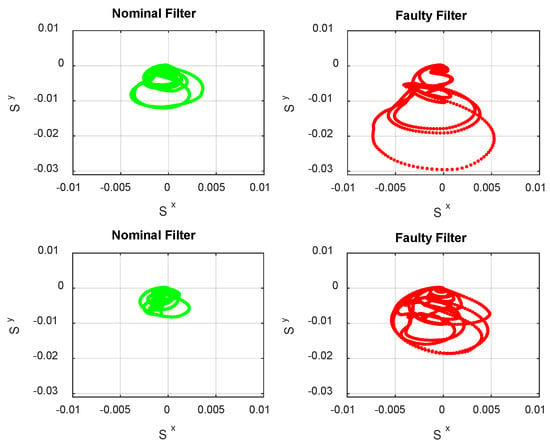
Figure 6.
Signature pattern is sensitive to filtration efficiency change and allows an easy detection of DPF malfunction.
Due to the observed increased sensitivity of the signature pattern in the vertical direction, the following character with and has been identified to be a suitable feature as a DPF malfunction indicator for the diagnostic algorithm.
The above character using dispersed data generated from 100 NEDC cycles with healthy and faulty filters is shown on Figure 7. Simultaneous dispersions on engine-out soot emissions (3σ = 30%) and sensor response (3σ = 15%) were added.
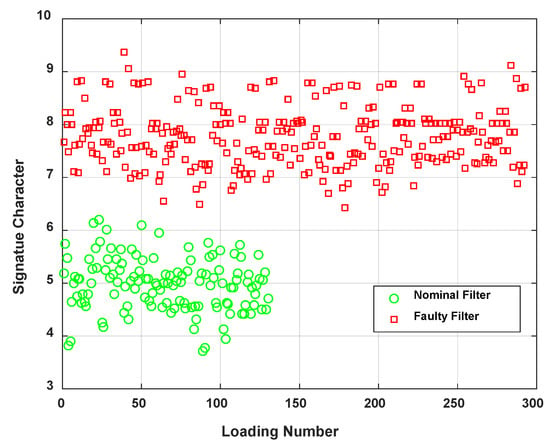
Figure 7.
Signature character for nominal and faulty cases based on dispersed data using 100 NEDC driving cycles.
Figure 7 illustrates the evident impact of particulate filter malfunction on the selected character. A clear separation into two distinct classes is evident, enabling easy differentiation between healthy and faulty DPF conditions. Therefore, a relevant detection threshold can be easily derived based on statistical analysis, which can lead to good diagnostic performance.
The adaptive strategy design aims to enhance the system’s ability to effectively discriminate between nominal and faulty filters, thereby leading to a robust diagnostic algorithm. To achieve this, a correction factor is applied to the generated characters according to the engine’s operating conditions.
An optimized correction factor is computed based on the integrals of engine speed measurements and IMEP set points during each sensor loading time. This ensures that the correction factor is dynamically updated with respect to the driving conditions, further improving the diagnostic performance. The training data used to fill the correction map represents 20% of the generated data. The optimization algorithm is driven by the following cost function:
where and are, respectively, the average and standard deviation of the corrected faulty and nominal characters using the training dataset. ) are tuning parameters that represent weighing factors of the contributions of average distance and standard deviations. The following figures demonstrate the significant impact of these parameters on the effectiveness of discriminating between faulty and nominal data. The resulting adaptive character is defined as follows.
Figure 8 and Figure 9 show the correction map and the adaptive character for . In this case, the optimization cost only takes into account the standard deviations of the faulty and nominal training data. A cost based on average values leads to the results of Figure 10 and Figure 11. In both cases, the adaptive characters exhibit significantly superior discrimination capabilities compared to the initial characters presented in Figure 7 with an advantage in the second case.
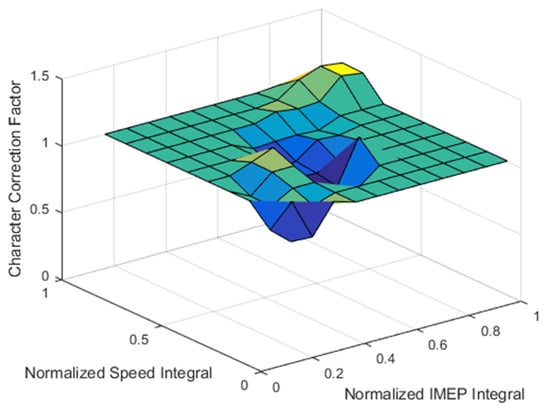
Figure 8.
Correction factor map for : The optimization cost is based on the standard deviations of faulty and nominal data.

Figure 9.
Adaptive characters for nominal and faulty filters when .
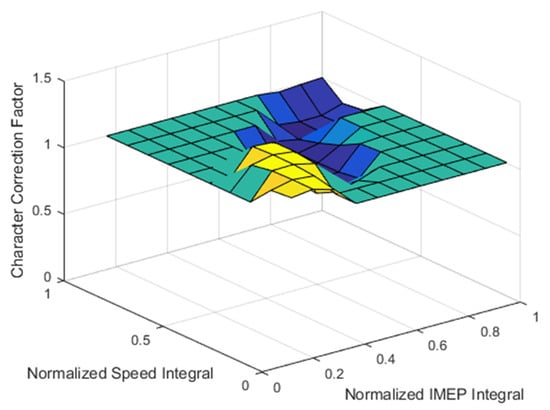
Figure 10.
Correction factor map for : The optimization cost is based on averages of faulty and nominal data.
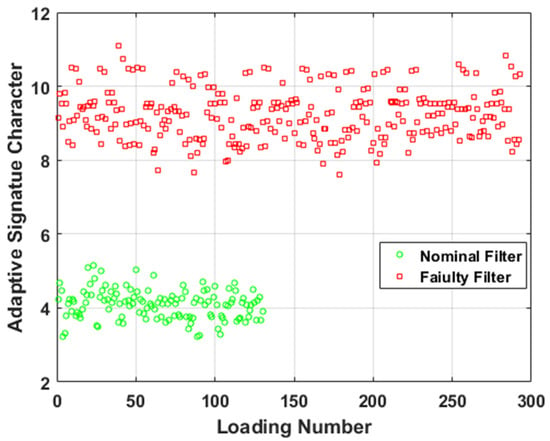
Figure 11.
Adaptive characters for nominal and faulty filters when .
To select the best combination of averages and standard deviations in the cost function, several weights have been evaluated as depicted in Figure 12. The discrimination ability is based on a distance D defined as follows.
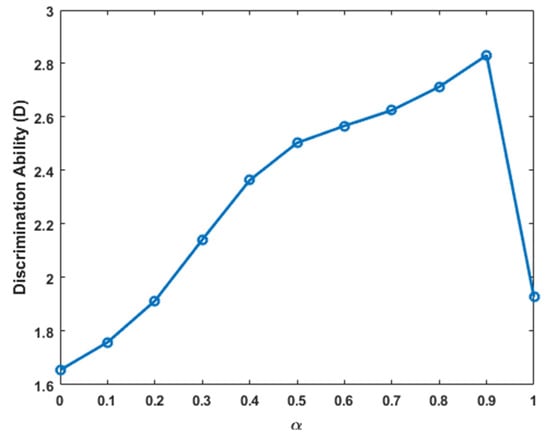
Figure 12.
Performance using different weights of the optimization cost: The best performance corresponds to .
The minimum distance (lower diagnostic performance) corresponds to , where the average values are not considered in the optimization cost. The diagnostic performance is improved when the weight on averages increases till a maximum distance for . For , where only averages are considered, the discrimination ability decreases again. In conclusion, optimal performance is achieved when both standard deviations and averages are incorporated into the cost function, with weights of 10% and 90%, respectively. The resulting correction map and adaptive character are shown in Figure 13 and Figure 14, which reflect the highest classification performance.
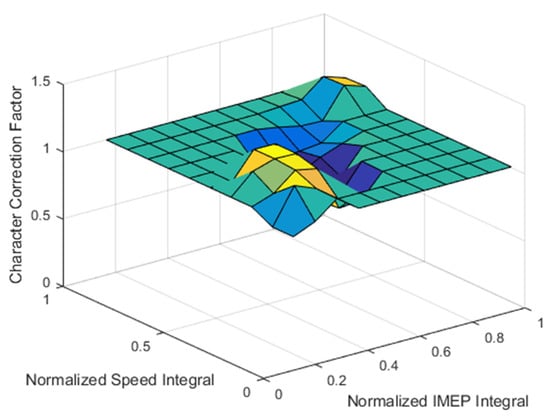
Figure 13.
Correction factor map for : The optimization cost is based on averages and standard deviations with weights of 90% and 10%, respectively.
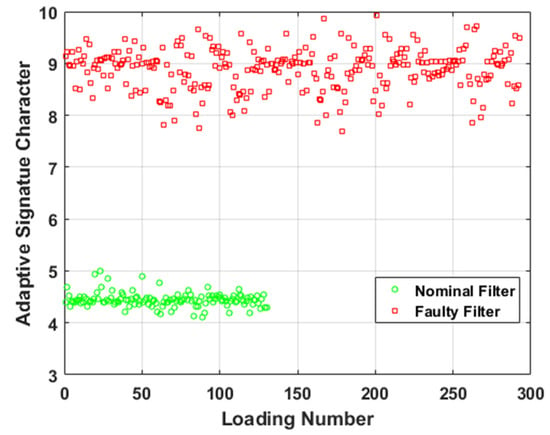
Figure 14.
Adaptive characters for nominal and faulty filters for .
In the sequel to the paper, a comparative analysis between the adaptive diagnostic strategy based on the above optimal correction map and a baseline strategy that processes sensor data without incorporating engine-related variables is conducted.
6. Comparison Between Adaptive and Non-Adaptive Diagnostic Strategies
This section highlights the benefits of coupling the soot sensor data and engine operating conditions for the diagnostic algorithm. It shows the advantage of the adaptive approach compared to the diagnostic strategy based on the unique use of the soot sensor signal. Figure 15 illustrates the classification ability for the adaptive case where the signature’s character is dynamically adjusted according to engine speed and IMEP setpoint. Probability distribution functions are provided using nominal and faulty characters based on normal law. The comparison with the distribution functions of the initial character depicted in Figure 16 clarifies the relevance and superiority of the adaptive approach and further solidifies its significance and importance. Table 1 shows the diagnostic performance in terms of false alarms and missed detections with respect to the detection threshold for both approaches. Clearly, the adaptive approach offers a better classification capacity and allows us to design a diagnostic strategy with higher performance in terms of precision and robustness. The detection threshold can be defined as follows:
where is a tuning coefficient that directly impacts the false alarm and non-detection rates. It has been calibrated to assess the diagnostic performance for a detection threshold in the range [5 8] as shown in Table 1. and are given by Equations (12) and (14).
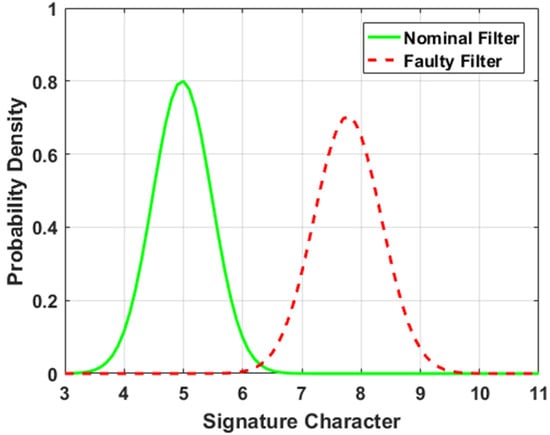
Figure 15.
Probability density approximations based on normal law using signature character for nominal and faulty filters.
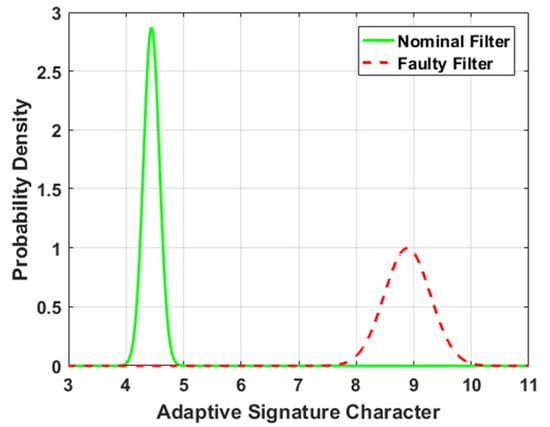
Figure 16.
Probability density approximations based on normal law using adaptive signature character for nominal and faulty filters.

Table 1.
False alarm and non-detection rates for different detection thresholds based on the adaptive diagnostic strategy and when using the sensor signal as the sole input for the diagnostic strategy. PPM: Part Per Million.
The occurrence of false alarms and non-detections should be minimized for a robust diagnostic algorithm. To effectively address these competing concerns, manufacturers must carefully calibrate the system’s detection threshold. A low threshold can minimize missed detections but may increase the likelihood of false alarms. Conversely, a high threshold can reduce false alarms but may result in more missed detections. The optimal threshold should strike a balance between these two extremes. It should be set at a level that minimizes both false alarms and non-detections while also considering the specific requirements of the application and the potential consequences of each type of error. These latter carry different weight from the manufacturer’s perspective. Automotive manufacturers often prioritize reducing false alarms to avoid customer dissatisfaction and high rates of returns. Conversely, they must also meet regulatory standards regarding missed detections. Therefore, the detection threshold must be carefully calibrated to ensure that false alarm and missed detection rates are kept within acceptable limits. A threshold value within the range of 5.5 to 6.5 is optimal for the adaptive strategy. However, a threshold between 6.5 and 7 offers a reasonable compromise when using the sensor signal as the sole input for the diagnostic strategy.
7. Conclusions
This paper investigates an adaptive diagnostic strategy for diesel particulate filters (DPFs). A 2D signature is generated from soot measurements during each sensor regeneration cycle. The generation process involves projecting the soot sensor signal onto a lower-dimensional space, where key features related to DPF performance can be more easily identified. To account for the variability of vehicle driving conditions, the diagnostic algorithm incorporates engine operating conditions into the decision-making process. The combination of soot sensor projection and engine operating condition-based optimization enables the algorithm to accurately identify DPF faults, even in the presence of soot measurement dispersions and engine-out soot emissions variations. An adaptive character is derived based on the signature’s sensitivity to DPF malfunction and an operating conditions-dependent correction factor. This correction factor is optimized using the integrals of the engine speed measurements and the IMEP setpoints during each sensor loading time, ensuring a dynamic adjustment to the driving conditions. The optimization algorithm minimizes a cost function that takes into account the mean and standard deviation of the faulty and nominal adaptive characters, based on a training dataset comprising 20% of the tested data. In contrast to model-based methods, which require complex subsystem models and potentially inaccurate engine-out soot concentration estimation, the proposed approach directly utilizes sensor signals and engine variables, simplifying the diagnostic algorithm and improving robustness. The obtained results demonstrate the effectiveness of the adaptive strategy in accurately classifying nominal and faulty filters using a statistically derived detection threshold. The robustness is improved with significant reductions of missed detections and false alarms compared to a diagnostic strategy relying solely on the sensor signal. The proposed adaptive strategy can be easily integrated into the sensor control unit to provide efficient DPF diagnostics. In conclusion, the adaptive DPF diagnostic strategy presented herein offers a promising advancement towards more reliable, efficient, and intelligent emissions diagnostics. Future research will investigate the influence of diverse driving cycles on the derived correction maps and explore the potential of machine learning methodologies for further enhancement and optimization of the proposed diagnostic strategy.
Funding
This research received no external funding.
Data Availability Statement
The data presented in this study are available on request from the corresponding author.
Conflicts of Interest
The author declare no conflict of interest.
References
- Chen, C.; Zhang, Y.; Khosravi, M.R.; Pei, Q.; Wan, S. An intelligent platooning algorithm for sustainable transportation systems in smart cities. IEEE Sens. J. 2020, 21, 15437–15447. [Google Scholar] [CrossRef]
- Brunel, O.; Duault, F.; Youssef, B.; Lave, J.; Creff, Y. Smart soot sensor for particulate filter OBD. In Advanced Microsystems for Automotive Applications 2013: Smart Systems for Safe and Green Vehicles; Springer International Publishing: Berlin/Heidelberg, Germany, 2013; pp. 351–361. [Google Scholar]
- Habboush, S.; Rojas, S.; Rodríguez, N.; Rivadeneyra, A. The Role of Interdigitated Electrodes in Printed and Flexible Electronics. Sensors 2024, 24, 2717. [Google Scholar] [CrossRef] [PubMed]
- Youssef, B. Trapped mass estimation in automotive diesel engines based on in-cylinder pressure signal projection. Int. J. Adapt. Control. Signal Process. 2020, 34, 1751–1767. [Google Scholar] [CrossRef]
- Zhang, Z.; Dong, R.; Tan, D.; Zhang, B. Multi-objective optimization of performance characteristic of diesel particulate filter for a diesel engine by RSM-MOPSO during soot loading. Process Saf. Environ. Prot. 2023, 177, 530–545. [Google Scholar] [CrossRef]
- Hu, W.; E, J.; Leng, E.; Zhang, F.; Chen, J.; Ma, Y. Investigation on harvesting characteristics of convective wind energy from vehicle driving on multi-lane highway. Energy 2023, 263, 126062. [Google Scholar] [CrossRef]
- Gainey, B.; Yan, Z.; Lawler, B. Autoignition characterization of methanol, ethanol, propanol, and butanol over a wide range of operating conditions in LTC/HCCI. Fuel 2021, 287, 119495. [Google Scholar] [CrossRef]
- Liu, Z.; Dizqah, A.M.; Herreros, J.M.; Schaub, J.; Haas, O. Simultaneous control of NOx, soot and fuel economy of a diesel engine with dual-loop EGR and VNT using economic MPC. Control Eng. Pract. 2021, 108, 104701. [Google Scholar] [CrossRef]
- Maurya, R.K. Reciprocating Engine Combustion Diagnostics: In-Cylinder Pressure Measurement and Analysis; Springer: Berlin/Heidelberg, Germany, 2019. [Google Scholar]
- Lelieveld, J.; Evans, J.S.; Fnais, M.; Giannadaki, D.; Pozzer, A. The contribution of outdoor air pollution sources to premature mortality on a global scale. Nature 2015, 525, 367–371. [Google Scholar] [CrossRef]
- Cai, T.; Zhao, D.; Chan, S.H.; Shahsavari, M. Tailoring reduced mechanisms for predicting flame propagation and ignition characteristics in ammonia and ammonia/hydrogen mixtures. Energy 2022, 260, 125090. [Google Scholar] [CrossRef]
- Stohl, A.; Aamaas, B.; Amann, M.; Baker, L.H.; Bellouin, N.; Berntsen, T.K.; Boucher, O.; Cherian, R.; Collins, W.; Daskalakis, N.; et al. Evaluating the climate and air quality impacts of short-lived pollutants. Atmos. Chem. Phys. 2015, 15, 10529–10566. [Google Scholar] [CrossRef]
- Muñoz, X.; Barreiro, E.; Bustamante, V.; Lopez-Campos, J.L.; González-Barcala, F.J.; Cruz, M.J. Diesel exhausts particles: Their role in increasing the incidence of asthma. Reviewing the evidence of a causal link. Sci. Total Environ. 2019, 652, 1129–1138. [Google Scholar] [CrossRef] [PubMed]
- Cai, T.; Zhao, D. Enhancing and assessing ammonia-air combustion performance by blending with dimethylether. Renew. Sust. Energ. Rev. 2022, 156, 112003. [Google Scholar] [CrossRef]
- Li, S.; Liu, J.; Li, Y.; Wei, M.; Xiao, H.; Yang, S. Effects of fuel properties on combustion and pollutant emissions of a low temperature combustion mode diesel engine. Fuel 2020, 267, 117123. [Google Scholar] [CrossRef]
- Dave, H.; Solanki, D.; Naik, P. Effect of pilot fuel quantity and fuel injection pressure on combustion, performance and emission characteristics of an automotive diesel engine. Int. J. Thermofluids 2024, 21, 100570. [Google Scholar] [CrossRef]
- Zhang, Z.; Tian, J.; Xie, G.; Li, J.; Xu, W.; Jiang, F.; Huang, Y.; Tan, D. Investigation on the combustion and emission characteristics of diesel engine fueled with diesel/methanol/n-butanol blends. Fuel 2022, 314, 123088. [Google Scholar] [CrossRef]
- Siddartha, G.N.V.; Ramakrishna, C.S.; Kujur, P.K.; Rao, Y.A.; Dalela, N.; Yadav, A.S.; Sharma, A. Effect of fuel additives on internal combustion engine performance and emissions. Mater. Today Proc. 2022, 63, A9–A14. [Google Scholar] [CrossRef]
- Du, Y.; Hu, G.; Xiang, S.; Zhang, K.; Liu, H.; Guo, F. Estimation of the diesel particulate filter soot load based on an equivalent circuit model. Energies 2018, 11, 472. [Google Scholar] [CrossRef]
- Zhang, Y.; Zhang, Y.; Lin, Y.; Fang, L.; Lou, D. Particle filter performance of soot-loaded diesel particulate filter and the effect of its regeneration on the p-article number and size distribution. J. Clean. Prod. 2024, 461, 142651. [Google Scholar] [CrossRef]
- Nakagoshi, Y.; Mori, K.; Tanaka, K.; Furuta, Y. New Generation Diesel Particulate Filter for Future Euro7 Regulation. SAE Int. J. Adv. Curr. Pract. Mobil. 2023, 6, 688–695. [Google Scholar]
- Cavallo, D.M.; Chiavola, O.; Palmieri, F.; Mancaruso, E.; Vaglieco, B.M. Experimental study on the effect of loading and regeneration for an optimized management of the DPF. Results Eng. 2023, 18, 101048. [Google Scholar] [CrossRef]
- Yu, M.; Balakotaiah, V.; Luss, D. Effect of DPF Properties on Maximum Temperature Rise following a DTI. No. 2014-01-1561. In SAE Technical Paper; SAE International: Washington, DC, USA, 2014. [Google Scholar]
- Huang, T.; Hu, G.; Meng, Z.; Zeng, D. IMC-based diesel oxidation catalyst outlet temperature control with extended state predictor observer. Control Eng. Pract. 2021, 117, 104939. [Google Scholar] [CrossRef]
- Brunel, O.; Duault, F.; Lavy, J.; Creff, Y.; Youssef, B. Smart Soot Sensor for Particulate Filter OBD. SAE Int. J. Passeng. Cars Electron. Electr. Syst. 2013, 6, 307–327. [Google Scholar] [CrossRef]
- Kontses, D.; Geivanidis, S.; Fragkiadoulakis, P.; Samaras, Z. Uncertainties in model-based diesel particulate filter diagnostics using a soot sensor. Sensors 2019, 19, 3141. [Google Scholar] [CrossRef] [PubMed]
- Oh, K.C.; Lee, K.B.; Jeong, B.G. Characteristics of Resistive PM Sensors for Onboard Diagnostics of Diesel Particulate Filter Failure. Sensors 2022, 22, 3767. [Google Scholar] [CrossRef]
- Youssef, B.; Creff, Y. Method for Diagnosing a Particle Filter by Means of a Soot Capturing Device. U.S. Patent 9,556,780, 31 January 2017. [Google Scholar]
- Kamimoto, T. A review of soot sensors considered for on-board diagnostics application. Int. J. Engine Res. 2017, 18, 631–641. [Google Scholar] [CrossRef]
- Kupper, M.; Pulko, J.; Kraft, M.; Bergmann, A. First Steps towards a Super-Compact In-Situ Laser-Induced-Incandescence Sensor System. Proceedings. 2019, 2, 1017. [Google Scholar]
- Maricq, M.M.; Bilby, D. The impact of voltage and flow on the electrostatic soot sensor and the implications for its use as a diesel particulate filter monitor. J. Aerosol Sci. 2018, 124, 41–53. [Google Scholar] [CrossRef]
- Feulner, M.; Hagen, G.; Hottner, K.; Redel, S.; Müller, A.; Moos, R. Comparative study of different methods for soot sensing and filter monitoring in diesel exhausts. Sensors 2017, 17, 400. [Google Scholar] [CrossRef]
- Bilby, D.; Kubinski, D. Design principles for controlling soot deposition location in resistive PM sensors. Sens. Actuators A Phys. 2021, 330, 112871. [Google Scholar] [CrossRef]
- Kontses, D.; Geivanidis, S.; Samaras, Z. 2.1. 5 Review of Legislative Requirements and Methods for the Estimation of PN/PM Emissions for Advanced Light-duty OBD Applications. In Proceedings of the 23rd Transport and Air Pollution (TAP) Conference–Part I, Thessaloniki, Greece, 15–17 May 2020. [Google Scholar]
- Yamamoto, M.; Maeda, E.; Todo, Y.; Nakato, M. Development of Fast Response Time PM Sensor. No. 2020-01-0390. In SAE Technical Paper; SAE International: Washington, DC, USA, 2020. [Google Scholar]
- Grondin, D.; Breuil, P.; Viricelle, J.; Vernoux, P. Modeling of the signal of a resistive soot sensor, influence of the soot nature and of the polarization voltage. Sens. Actuators B Chem. 2019, 298, 126820. [Google Scholar] [CrossRef]
- Ochs, T.; Schittenhelm, H.; Genssle, A.; Kamp, B. Particulate matter sensor for on board diagnostics (OBD) of diesel particulate filters (DPF). SAE Int. J. Fuels Lubr. 2010, 3, 61–69. [Google Scholar] [CrossRef]
- Youssef, B.; Alamir, M. Generic signature generation tool for diagnosis and parametric estimation of multi-variable dynamical nonlinear systems. In Proceedings of the 42nd IEEE International Conference on Decision and Control (IEEE Cat. No. 03CH37475), Maui, HI, USA, 9–12 December 2003; IEEE: New York, NY, USA, 2003; Volume 1, pp. 966–971. [Google Scholar]
- Youssef, B.; Corde, G. Method of Testing Engines Based on Graphic Signatures. European Patent EP2212537 B1, 2012. [Google Scholar]
- Youssef, B. Innovative Model-Free Onboard Diagnostics for Diesel Particulate Filter. SAE Int. J. Engines 2023, 17, 413–424. [Google Scholar] [CrossRef]
Disclaimer/Publisher’s Note: The statements, opinions and data contained in all publications are solely those of the individual author(s) and contributor(s) and not of MDPI and/or the editor(s). MDPI and/or the editor(s) disclaim responsibility for any injury to people or property resulting from any ideas, methods, instructions or products referred to in the content. |
© 2025 by the author. Licensee MDPI, Basel, Switzerland. This article is an open access article distributed under the terms and conditions of the Creative Commons Attribution (CC BY) license (https://creativecommons.org/licenses/by/4.0/).